I'm still alive, I know that a lot of my blog readers get nervous when I vanish for a week at a time. All who know me realize that I have probably fallen to sleep in the chair with some small critter.
It is AWESOME being out of school for the summer. July and August are definitely a great perk of being a teacher. New York Wildlife Rescue Center hasn't slowed down much in the last week. Since last time I blogged a lot of new animals have found their way here.
Cornell contacted me this am. They are going to release the story about the bobcat Oscar to the media. I think that it is a great human interest story. It isn't every day that a bobcat gets hit, lays along the road and gets a second chance on life. Oscar continues the slow rehabbing process. He doesn't like me any more than he ever has but I think he has started to realize that when I check on him a couple of times a day, there is always food associated with my visits. I try not to make eye contact with him. Most "cats" don't like that, he is a lucky kitty.... I feel honored to be his caretaker and one of the dozens of people who have cooperated to rescue him.
Since last blog (sorry), we have taken in baby robins, fawns, skunks, kestrels, hawks, cottontail rabbits, raccoons, a kingfisher, pigeons, and a squirrel. Ray Baitsholts sheared the alpacas that I picked up. As soon as they get gelded, they will be ready for adoption. I am having a lot of fun with the baby robins, they are a relatively easy bird to rehab. I normally do not rehab baby birds while I am teaching at school. It is too hard to teach and feed them every 15-25 minutes. :) I do like to do a few during the summer when I am home.
I have had a couple of fawns come in this past week. One was horribly torn apart by some dogs. I notified some great DEC Officers about that situation. I've already given you the lecture about domestic cats in a prior blog. Supervise your dog(s); when left to amuse themselves unsupervised, dogs often develop a pack mentality. They are capable of some horrible things to wildlife. Wildlife gets killed, your dog can be shot and you can get some expensive tickets. No lecture, just use common sense. Do the right thing.
I had some more skunks come in. I love skunks, they have such a Napoleonic attitude. They act fearless and it is always fun watching them grow up into little stink pots. I love it on release day. They usually just wander off and rarely look back or acknowledge anything that you have done for them at all. That is the best part of rehabbing wildlife: if done well, they can't wait to get away from you and do what they do to survive day to day in the wild. If you know what you are doing, you don't usually get sprayed.... :)
I've had a few Kestrels come in. People often call them Sparrow Hawks but they are actually one of the smallest members of the Falcon family of raptors. It is VERY Important that you do not try to feed animals while in your custody unless properly trained. I had a Kestrel come in that I lost and I believe that feeding it a bunch of gypsy moth caterpillars didn't help it any. I got fluids/a lactated ringer into it but it was too far gone by the time it got to me.
The Kestrels are loving one of the 8 newly completed aviaries in our Raptor Center. Justin and Chris have been coming nights after they are done working to try to help me get it finished for our upcoming Open House and dedication of the Raptor Center. I will hopefully have all of the details of our Open House tomorrow. It will be a great chance to tour our facility. We do NOT let the public see animals that we are rehabbing that will go back into the wild but we do have some great non-releasable educational animals here that will love to see you.
Another new resident of the Raptor Center is a Red-tailed Hawk. I got a call early in the morning a few days ago. The man informed me that he had a baby juvenile Bald Eagle which got my attention quick. Upon pick up, I happily let him know that it was a juvenile Red-tailed Hawk. Why it was sitting in the road I haven't been able to figure out. It will be going back into the wild as soon as it is ready.
Cottontail rabbits, hmmmmmm. Lots of them coming in. I am in a good mood: when your dog or cat brings one home for you -- don't wait until the whole litter is on your porch (or eaten) before realizing that you should keep your dog or cat inside for a while.
Coons, I cant wait until "Coon Season" is over. DON'T TOUCH THEM and I encourage everyone that is a licensed wildlife rehabilitator to go to the Conference in Lake George this November. Take the courses, get your shots, build a facility, get it all inspected and GET YOUR RVS license! There are not enough licensed people doing Rabies Vector Species and those of us that are doing raccoons, skunks and bats are usually full to capacity.
The Kingfisher bird that came in was a first for me, awesome bird but unfortunately had a wing that was so badly broken that it needed to be euthanized. I took in some pigeons. One of them is hysterical. If you are outside here, it will dive bomb you and land on your head to ride around.
My kids have never spent so much time outdoors. People that come to our facility must think that we are all nuts, as my kids are walking around the yard with a pigeon on their head.
Speaking of crazy stories ... one more then I have to catch up with 147 emails ... I got a call from the Pastor of a local church. He had heard that if an animal needed to be caught to call me (wonder how I got that reputation). He said that they had a feral cat, it was living under the church and if I could humanely deal with it, I would get a donation. Now you are talking. I packed up the kids and live traps and off we went this am. Got to the church, saw the hole in the foundation and all sorts of great visions came to my head about all the cool animals that could be living under there..... I was making up a irresistible kitty platter to put in one of the several live traps when I noticed that there was a very cute blue eyed Siamese long haired cat sitting by the shrub several feet away watching the whole production. We had a short mental conversation about what was happening. I walked several feet away, the cat walked over and walked right into the live trap. I do not need another cat but she has taken up residence in my basement until she realizes that life with us isn't so bad -- that is unless I find a great home that wants her (hint, hint)....
Till tomorrow, act young, have fun.
Wes
Please also see our other blog at
http://nywildliferescue.blogspot.com/
It is more active than this one. Always check there for updates, too.
Northeast Llama Rescue was started by Wes and Darcy Laraway of Middleburgh, NY.
Several years ago they rescued their first llama out of a tiny horse pen. Since that day, Northeast Llama Rescue has helped dozens of Camelids from several different states. The primary mission of Northeast Llama Rescue is to educate owners on how to properly care for their animals.
We also offer assistance with a traveling chute to shear, worm, and trim toenails on hard to handle animals. A 'TRUE REPUTABLE BREEDER" should help out the llama down the road that is not being cared for by owners that understand the needs of llamas.
If you know of a llama owner who is no longer able to care for their animals, there is help available. Members of Northeast Llama Rescue will adopt any unwanted animals. Rescue animals will be relocated to farms of members for training and necessary vet work.
If a llama is able to be rehabilitated, he will be available after a careful screening process. All rescues are placed in homes with a contract that says they shall be provided for and can not be sold. In the event a rescue animal becomes unwanted, the llama MUST be returned to Northeast Llama Rescue.
If you share our philosophy and love for the animals, you are more than welcome to join us! There are lots of llamas that need a person to love.
We also rescue farm animals, and are licensed wildlife rehabilitators.
This site is copyrighted by Wes Laraway.
Friday, July 3, 2009
Subscribe to:
Post Comments (Atom)
Northeast Llama Rescue by Wes Laraway
The Northeast Llama Rescue was started by Wes and Darcy Laraway several years ago after they rescued their first llama out of a tiny horse pen. Since that day, the Northeast Llama Rescue has helped dozens of animals in 5 states. The primary mission of Northeast Llama Rescue is to educate owners on how to care for their animals properly. We also offer assistance with a traveling chute to shear, worm and trim toenails on hard to handle animals. If owners get "tired" of the daily maintenance of their herds, members of the Northeast Llama Rescue will adopt or buy, if possible, any unwanted animals. Rescue animals go to the farms or members of the organization.
The Northeast Llama Rescue does not wish to compete with other rescue organizations, although any llama or alpaca is welcome. We need to cooperate to help ALL camelids, not just registered or "nice-looking" ones. Everyone has the right to breed and sell llamas, but a true reputable breeder will "help out" the llama down the road that is not being cared for, regardless of its age, sex or conformation.
Our last rescue came from Central New York. A farm had purchased 9 animals from a Midwest auction. Four of the animals had died from natural causes....starvation? The owner had health problems and no longer wanted the animals. After several other concerned people failed to negotiate their sale, I eventually called and within five minutes we had agreed on a price and the deal was done. The next night, Wes Laraway, Kim Scheurerman and P.J. Wagner went to pick up the animals. The owner informed us that the llamas were wild and could not be handled. Within five minutes all were calmly caught, on lead ropes and in the trailer, with us using a wand and some TEAM Training techniques. The owner thought I was the "llama whisperer" because I got those llamas to do things in five minutes that she couldn't do in a year. She unfortunately knew nothing about handling llamas.
Three hours later, we were back into quarantine at Red Maple Farm starting "damage control". The animals were immediately wormed, fed fresh hay and grain, and watered. All were body scored under three by sight and by feeling through their wool. This hands-on inspection revealed barbed wire that needed to be cut out of the fiber. We decided NOT to shear because it was too late in the year and they were too thin.
Another concern was an ingrown halter. One of the best ways to remove ingrown halters is to undo the buckle(s) and cut the nose band with sharp toenail clippers on each side of the nose. Then gradually, over time, the remaining pieces will fall out. With application of an antibiotic cream, any wounds from the ingrown halter will heal quickly. In this particular case, the halter came out of the nose and was added to the "wall of shame" in our barn (along with the barbed wire and ear tags still on them from the auction they were purchased from). The blood stream stopped within fifteen minutes and now, after a month, we can tell that scarring will be minimal. Please tell everyone you know that owns camelids, NEVER leave a halter on a llama! Even in a week, with wet conditions, a halter can embed itself in a llama's nose.
My biggest concern was the 10 month old female that was exposed to her father. If bred, we decided to abort the unborn cria for the safety and well-being of the young female. None of these five animals were over the age of three years. All of them, over the following months, would need intense care and proper nutrition. The animals were all updated on health requirements and gelded. All of these animals would need training before they could go up for adoption.
New problems continuously arose. Two weeks after they arrived, one of the females surprised us with a weak, constipated fourteen pound male cria. Within hours I knew it wasn't "normal" so mom and baby were moved to a quarantine pen in the barn. The decision was made to supplement the cria with goat colostrum and give him an enema. Although the cria was walking, he continued to strain to relieve himself. Around the clock surveillance did not reveal any nursing or defecation. At two days old, I found very small maggots between the cria's toes and by his umbilical cord. After consulting my vet again, the cria got a bath and dried out in the heated office before going back to mom in the barn. My vet explained that crias born on rainy days must be completely dry or flies will lay eggs in moist areas of umbilical fluid. I've never heard of this problem before but I know now to check my newborn crias for maggots every day. After five days of constant care, we lost "Trooper"....I guess it was not meant to be, but we tried.
The rest of the animals are doing well today. Concerned individuals found them, bought them and will protect them. Today is actually a special day, because the vet did fecals on them and all five of them are parasite free and can join our llama herd. After training and further rehabilitation, by Spring 2001 this group of animals will be available for adoption to carefully approved homes. All animals sold or placed by Northeast Llama Rescue will be adopted with a legal contract. The contract states that if the llama ever becomes unwanted or is not cared for properly, the animal will return to Red Maple Farm for a full refund. I used to think I could save every unwanted llama in the world...I know that I can't . It is too great an undertaking for one farm to rescue all the unwanted camelids out there. For this reason, several other farms have joined in the effort with Red Maple Farm to pool resources and save neglected and unwanted camelids.
Any farm that shares our philosophy that every llama deserves a life with proper care is welcome to join us. We are people who genuinely love all llamas and want to make a difference one llama at a time. Eventually we will print an educational brochure to hand out at events with member farms listed. Don't just tell people that you love your llamas; show people by making a difference and actually save one. Always quarantine new animals for at least one month while getting wormings, vaccines and nutritional needs in order. Always do a fecal exam and consult your vet about when new animals should go out with the herd. Geld all males and most of all BE PATIENT. Llamas are very forgiving animals and will learn to love and trust again with gentle care and training.
The Northeast Llama Rescue does not wish to compete with other rescue organizations, although any llama or alpaca is welcome. We need to cooperate to help ALL camelids, not just registered or "nice-looking" ones. Everyone has the right to breed and sell llamas, but a true reputable breeder will "help out" the llama down the road that is not being cared for, regardless of its age, sex or conformation.
Our last rescue came from Central New York. A farm had purchased 9 animals from a Midwest auction. Four of the animals had died from natural causes....starvation? The owner had health problems and no longer wanted the animals. After several other concerned people failed to negotiate their sale, I eventually called and within five minutes we had agreed on a price and the deal was done. The next night, Wes Laraway, Kim Scheurerman and P.J. Wagner went to pick up the animals. The owner informed us that the llamas were wild and could not be handled. Within five minutes all were calmly caught, on lead ropes and in the trailer, with us using a wand and some TEAM Training techniques. The owner thought I was the "llama whisperer" because I got those llamas to do things in five minutes that she couldn't do in a year. She unfortunately knew nothing about handling llamas.
Three hours later, we were back into quarantine at Red Maple Farm starting "damage control". The animals were immediately wormed, fed fresh hay and grain, and watered. All were body scored under three by sight and by feeling through their wool. This hands-on inspection revealed barbed wire that needed to be cut out of the fiber. We decided NOT to shear because it was too late in the year and they were too thin.
Another concern was an ingrown halter. One of the best ways to remove ingrown halters is to undo the buckle(s) and cut the nose band with sharp toenail clippers on each side of the nose. Then gradually, over time, the remaining pieces will fall out. With application of an antibiotic cream, any wounds from the ingrown halter will heal quickly. In this particular case, the halter came out of the nose and was added to the "wall of shame" in our barn (along with the barbed wire and ear tags still on them from the auction they were purchased from). The blood stream stopped within fifteen minutes and now, after a month, we can tell that scarring will be minimal. Please tell everyone you know that owns camelids, NEVER leave a halter on a llama! Even in a week, with wet conditions, a halter can embed itself in a llama's nose.
My biggest concern was the 10 month old female that was exposed to her father. If bred, we decided to abort the unborn cria for the safety and well-being of the young female. None of these five animals were over the age of three years. All of them, over the following months, would need intense care and proper nutrition. The animals were all updated on health requirements and gelded. All of these animals would need training before they could go up for adoption.
New problems continuously arose. Two weeks after they arrived, one of the females surprised us with a weak, constipated fourteen pound male cria. Within hours I knew it wasn't "normal" so mom and baby were moved to a quarantine pen in the barn. The decision was made to supplement the cria with goat colostrum and give him an enema. Although the cria was walking, he continued to strain to relieve himself. Around the clock surveillance did not reveal any nursing or defecation. At two days old, I found very small maggots between the cria's toes and by his umbilical cord. After consulting my vet again, the cria got a bath and dried out in the heated office before going back to mom in the barn. My vet explained that crias born on rainy days must be completely dry or flies will lay eggs in moist areas of umbilical fluid. I've never heard of this problem before but I know now to check my newborn crias for maggots every day. After five days of constant care, we lost "Trooper"....I guess it was not meant to be, but we tried.
The rest of the animals are doing well today. Concerned individuals found them, bought them and will protect them. Today is actually a special day, because the vet did fecals on them and all five of them are parasite free and can join our llama herd. After training and further rehabilitation, by Spring 2001 this group of animals will be available for adoption to carefully approved homes. All animals sold or placed by Northeast Llama Rescue will be adopted with a legal contract. The contract states that if the llama ever becomes unwanted or is not cared for properly, the animal will return to Red Maple Farm for a full refund. I used to think I could save every unwanted llama in the world...I know that I can't . It is too great an undertaking for one farm to rescue all the unwanted camelids out there. For this reason, several other farms have joined in the effort with Red Maple Farm to pool resources and save neglected and unwanted camelids.
Any farm that shares our philosophy that every llama deserves a life with proper care is welcome to join us. We are people who genuinely love all llamas and want to make a difference one llama at a time. Eventually we will print an educational brochure to hand out at events with member farms listed. Don't just tell people that you love your llamas; show people by making a difference and actually save one. Always quarantine new animals for at least one month while getting wormings, vaccines and nutritional needs in order. Always do a fecal exam and consult your vet about when new animals should go out with the herd. Geld all males and most of all BE PATIENT. Llamas are very forgiving animals and will learn to love and trust again with gentle care and training.











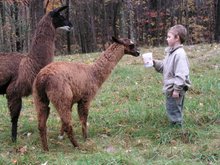
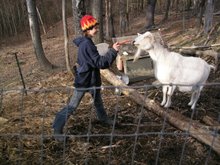

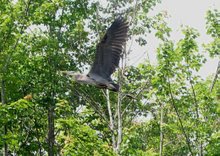

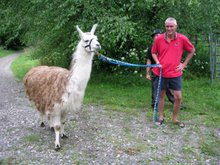
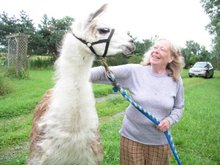
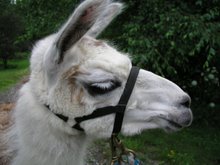








No comments:
Post a Comment